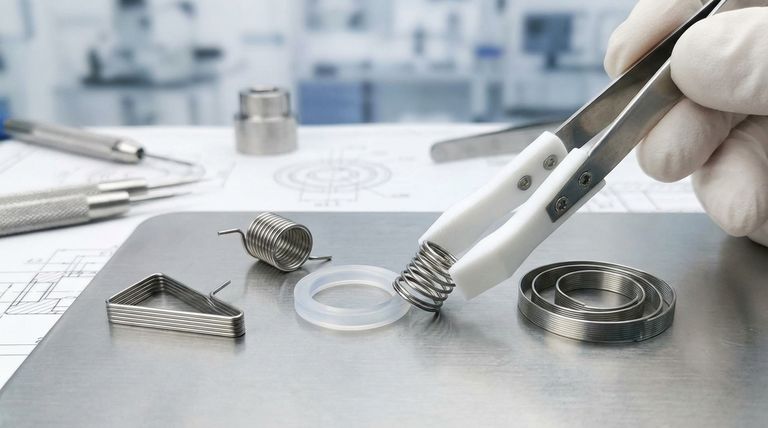The three primary spring options available for PTFE seals are Cantilever (often called a V-spring), Canted Coil, and Helical Ribbon springs. Each is designed with a distinct geometry to provide a specific type of mechanical force to the PTFE seal jacket. This energizing force is critical for ensuring the seal maintains contact and performs reliably, especially when system pressure is low or variable.
The type of spring energizer within a PTFE seal is not an interchangeable detail; it is a critical design choice. The spring's geometry—be it Cantilever, Canted Coil, or Helical—directly dictates the seal's performance characteristics and suitability for specific applications, such as rotary, reciprocating, or static service.

The Fundamental Role of the Spring Energizer
Before comparing spring types, it's essential to understand why the spring exists. A spring-energized seal combines a low-friction PTFE jacket with a metal spring to create a highly effective sealing system.
Providing a Constant Sealing Force
The spring provides a continuous radial force, pushing the PTFE seal lips against the mating surface. This ensures a tight seal even at zero or very low system pressures, where a standard seal might otherwise fail to actuate.
Compensating for System Variables
An energizer spring automatically compensates for minor imperfections. It adjusts for variations in gland tolerances and accounts for normal seal wear over the component's lifespan, ensuring consistent performance.
Enabling Precise Friction Control
Unlike a solid elastomer like an O-ring, the spring's force can be engineered with high precision. This allows for more accurate control over friction, a critical factor in dynamic applications.
A Breakdown of the Three Core Spring Types
The choice of spring is determined entirely by the demands of the application. Each type offers a different load profile.
The Cantilever Spring (V-Spring)
This energizer is formed from a flat metal strip bent into a characteristic 'V' or 'U' shape. It functions like a beam, concentrating a high load onto a specific point on the seal lip.
This high load concentration makes it an excellent choice for dynamic rotary applications, where it can effectively scrape away media and maintain a strong sealing line.
The Canted Coil Spring
A canted coil spring is made from round wire that is coiled and slanted into a 'C' shape. Its unique geometry provides a relatively constant force across a wide range of deflections.
This consistent loading makes it extremely versatile. It is the preferred choice for both rotary and dynamic reciprocating applications, where motion can cause pressure fluctuations.
The Helical Ribbon Spring
This spring is fabricated from a flat ribbon of metal wound into a helix, similar to a traditional coil spring. This design provides a very high, evenly distributed load.
Its high load characteristic is ideal for static or very slow dynamic applications, particularly in face seals where a powerful and consistent force is needed across a broad surface.
Understanding the Trade-offs: Spring Material
The spring's performance is not just a function of its geometry; the material it's made from is equally critical for system longevity and reliability.
The Importance of Material Selection
The spring material must be compatible with the system's media, temperature, and potential for corrosion. An incorrect material choice can lead to spring failure and, consequently, seal failure.
Common Corrosion-Resistant Alloys
To ensure durability, energizer springs are almost always made from high-performance alloys. Common choices include:
- Stainless Steel: A baseline for good corrosion resistance in many industrial applications.
- Elgiloy®: A cobalt-chromium-nickel alloy known for its exceptional strength, corrosion resistance, and performance at extreme temperatures.
- Hastelloy®: A nickel-molybdenum alloy offering outstanding resistance to highly corrosive chemical agents.
Selecting the Right Spring for Your Application
Your final choice should be guided by the specific motion and environmental conditions of your system.
- If your primary focus is high-speed rotary service: The Cantilever (V-spring) provides the high, concentrated load needed for effective sealing and media scraping.
- If your primary focus is dynamic reciprocating or mixed motion: The Canted Coil spring offers a consistent force over a wide deflection range, making it the most versatile and reliable option.
- If your primary focus is a static, high-pressure face seal: The Helical Ribbon spring delivers the powerful, evenly distributed load required for stationary applications.
Matching the spring's design to the application's demands is the key to unlocking the full performance potential of a PTFE seal.
Summary Table:
| Spring Type | Primary Application | Key Characteristic |
|---|---|---|
| Cantilever (V-Spring) | Dynamic Rotary | High, concentrated load for scraping |
| Canted Coil | Dynamic Reciprocating/Rotary | Consistent force over wide deflection |
| Helical Ribbon | Static / High-Pressure Face Seals | High, evenly distributed load |
Need the Perfect PTFE Seal for Your Application?
Choosing the right spring energizer is critical for seal performance, longevity, and reliability. KINTEK specializes in the precision manufacturing of custom PTFE seals—including seals, liners, and labware—for the semiconductor, medical, laboratory, and industrial sectors.
We provide expert guidance on spring selection and deliver custom fabrication from prototypes to high-volume orders, ensuring your seals meet exact specifications for motion, pressure, and media compatibility.
Contact KINTEK today to discuss your PTFE seal requirements and get a solution engineered for your success.
Visual Guide

Related Products
- Custom PTFE Parts Manufacturer for Teflon Parts and PTFE Tweezers
- Custom PTFE Parts Manufacturer for Teflon Containers and Components
- Custom PTFE Sealing Tapes for Industrial and High Tech Applications
- Custom PTFE Bottles for Diverse Industrial Applications
- Custom PTFE Teflon Balls for Advanced Industrial Applications
People Also Ask
- What industrial benefits do PTFE-machined parts offer? Achieve Peak Performance in Demanding Applications
- What challenges arise when machining PTFE (Teflon)? Overcome Softness, Heat, and Instability
- What finishing techniques are effective for machined Teflon parts? Achieve Functional Performance and Dimensional Stability
- What are the main applications of PTFE type Teflon? Unlock Its Versatility for Your Industry
- What fabrication services are available for PTFE? Shearing, Stamping, Laser Cutting, Molding & Machining



















